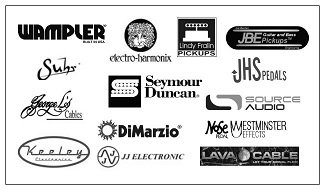The Micro Q-Tron is a smooth envelope filter with a funky wah-wah tone. The filter is controlled by its internal envelope follower, analyzing the volume of your notes and the dynamics of your playing to directly sweep the filter's center or cutoff frequency. A stronger attack or louder note will produce a wider frequency sweep while softer playing produces more subtle effects. Use the Q control to make the effect more dramatic.
Quick Specs
- True bypass
-Drive control sets sensitivity and filter sweep range
- Selectable low pass, band pass or high pass filters
- Q control sets the filter's bandwidth from smooth to funky
- Tough and compact die-cast chassis
- 9-volt battery included
- Optional 96DC-200BI power supply available (not included)
- Dimensions in inches: 4.0 (w) x 4.75 (l) x 2.25 (h)
- Dimensions in mm: 102 (w) x 121 (l) x 89 (h)
The Micro Q-Tron is a envelope controlled filter. The Micro Q-Tron is identical to our Mini Q-Tron but in a compact pedal. The envelope controlled filter is a unique type of sound modifier in which the user’s playing style controls the effect. The volume of the input signal (also called the envelope) controls the cutoff frequency or center frequency of a swept filter. As your instrument’s volume increases or decreases, so does the pitch of the filter.
-CONTROLS-
DRIVE CONTROL - This is the filter sweep sensitivity control. Turning the DRIVE control clockwise will cause the filter to react more to your playing. The more you turn up the DRIVE control, the higher in frequency the filter will jump when you play a note. When first plugging into the Micro Q-Tron, start with this control at 12 o’clock.
Q CONTROL - Determines the peak bandwidth of the filter. As the Q control is turned clockwise, the filter will sound increasingly narrow with a more obvious peak, making the effect more dramatic. Start with Q set to about 2 o’clock.
MODE ROTARY SWITCH (LP BP HP) - Determines what frequency range the filter will pass. Emphasizes lows in LP mode (Low Pass), midrange in BP mode (Band Pass) and highs in HP mode (High Pass).
STATUS LED - When the LED is lit, the Micro Q-Tron is in effect mode. When the LED is off, the Micro Q-Tron is True Bypass mode.
FOOTSWITCH - Toggles the Micro Q-Tron between effect and True Bypass modes.
CONNECTIONS - Connect your instrument to the INPUT Jack. Connect your amplifier to the AMP Jack.
-POWER-
POWER - Power, from the internal 9-volt battery or external battery eliminator, is activated by plugging into the Input jack. The input cable should be removed when the unit is not in use to avoid running down the battery. The barrel connector on the front of the Micro Q-Tron is for a 9-volt battery eliminator capable of delivering 100 mA of current. The inner ring of the 9-volt battery eliminator must be negative, the outer ring positive. The unit’s battery may be left in or taken out when the eliminator is in use.
BATTERY - The Micro Q-Tron can run off of a 9V battery. To change the 9-volt battery, you must remove the 4 screws on the bottom of the Micro Q-Tron. Once the screws are removed, you can take off the bottom plate and change the battery. Please do not touch the circuit board while the bottom plate is off or you risk damaging a component.
-PLAYING THE MICRO Q-TRON-
The Micro Q-Tron’s effect is controlled by the musician’s playing dynamics: a stronger attack or louder note will yield a more dramatic effect, while softer playing will produce more subtle effects. Use the full range of control settings in combination with different playing techniques to obtain a number of different and unique effects combinations. You might find that the DRIVE and Q controls work best when they are in the middle of their range rather than maximized.
When you play a note into the Micro Q-Tron, its filter will jump up to a high frequency and then slowly descend in frequency according to the envelope of the notes you play. The louder your note, the higher in frequency the filter jumps.

